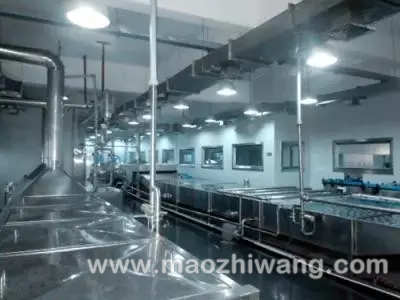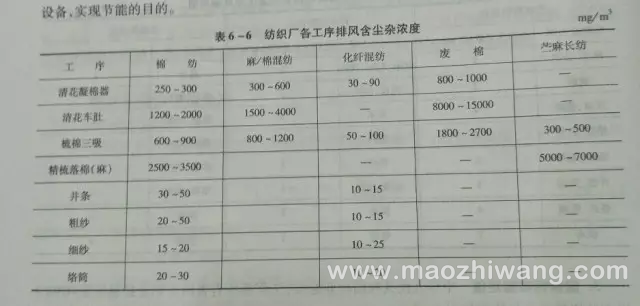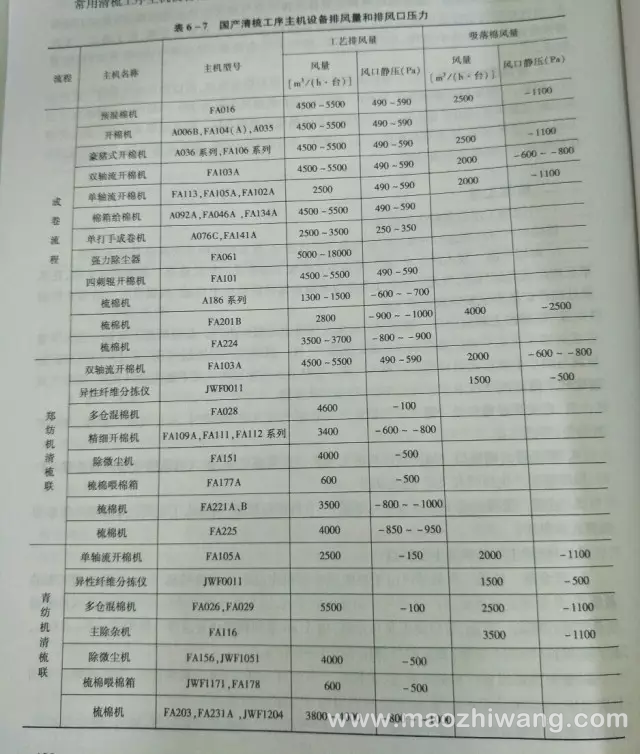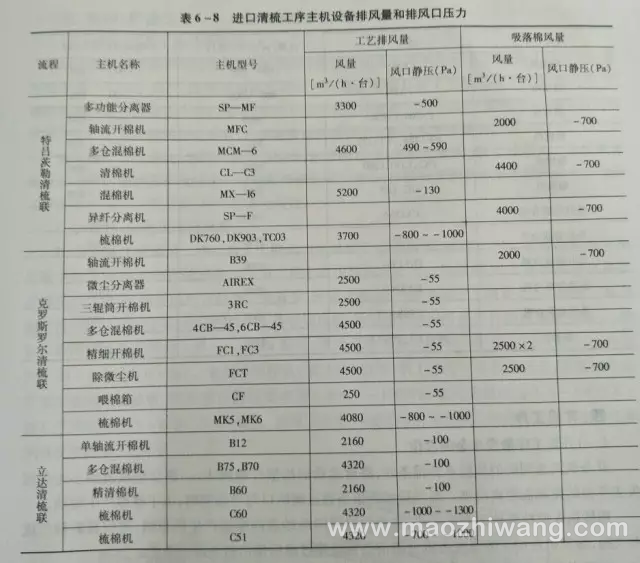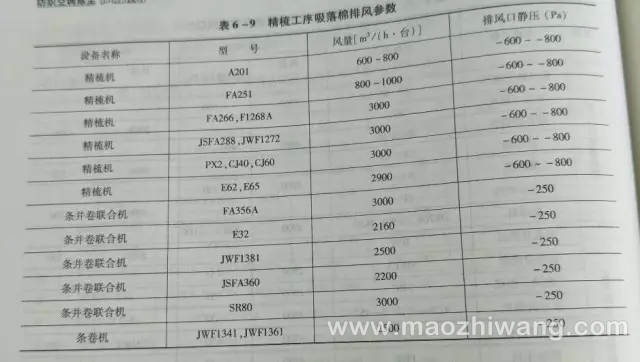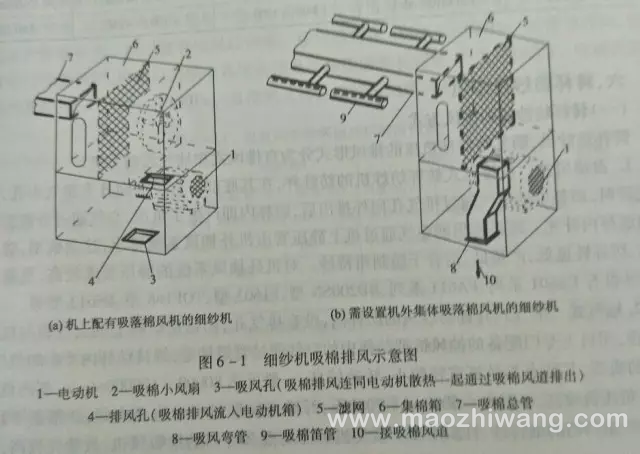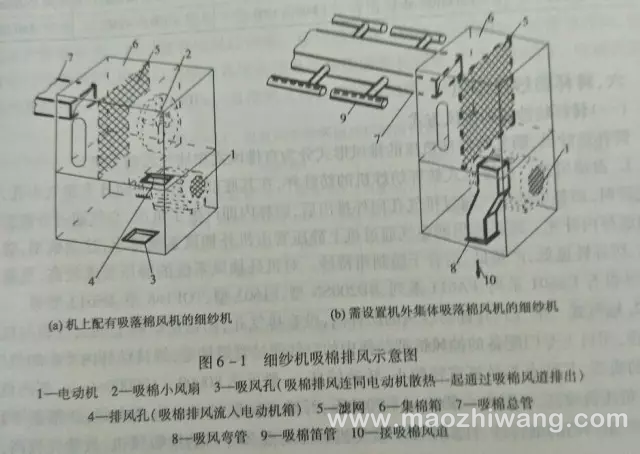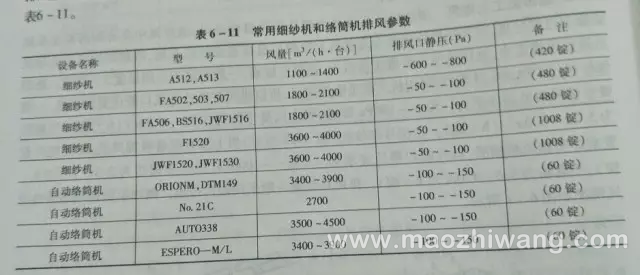The dust emitted from each process of the textile mill is related to the origin, processing location and method of raw cotton, raw cotton grade, impurity content, exhaust volume and other factors. The actual test data shall prevail. In the preliminary design, the dust concentration in the exhaust of each process in the textile mill is shown in Table 6-6. The dust-exhausting airflow discharged from various processes and parts of the textile mill has different characteristics of exhaust air. With the different types of processed fibers, the same process and location, the exhaust parameters are also different. Therefore, it is necessary to study in detail the exhaust situation of each process in the textile mill, the nature of the fiber dust contained, the air discharge capacity of the equipment and the exhaust pressure requirements, in order to correctly design the dust removal system and select suitable dust removal equipment to achieve energy saving purposes. Open cleaning process The open cleaning process mainly mixes, opens and removes the cotton fibers, and carries out the pneumatic conveying of the raw materials. The main features of the dust emitting part and the process exhaust in this process are described below. (1) The part where the dust is emitted 1, mixed cotton machine When the cotton picker beats the layer by layer in the cotton layer, the dust and short velvet in the raw cotton are emitted with the airflow. The raw cotton is separated from the condenser by the airflow into the mixing machine, and the fine dust and the short pile are discharged from the dust chamber of the condenser through the condenser fan to the external dust removal system. In the mixed cotton machine, the raw cotton is opened under the angle nails and the beaters. The larger dust passes through the dust under the beater and falls under the machine to form the car belly. The fine dust floats in the air and flows into the next machine with the linters. 2, cleaning machine The cleaning machine consists of a cotton box and a single hand winder. The cotton concentrator on the top of the cotton box can separate the raw cotton into the cotton box, and the short velvet and fine dust in the air are discharged from the external dust removal system by the condenser fan. Larger dust leaked into the car's belly. The single-handed roll-forming machine forms a lap of loose raw cotton on the dust cage, and the dust-removing airflow of the upper and lower dust cages is discharged from the external dust-removing system by the exhaust fan of the winder. (2) Main features of process exhaust 1, large exhaust air volume The main exhaust points of this process are mostly air discharge from the condenser, exhaust air in the coiling machine, and exhaust and exhaust in the car belly. The air volume of each condenser is 4500~5500m3/h, each roll The exhaust air volume of the machine is 2500~3000m3/h, and the total exhaust air volume of each set of winding technology is 24000~31000m3/h, and the air volume of the car belly is not included. For the equipment of the carding and combing process, due to the high output, the suction point is large, and the exhaust air volume is larger, and the air volume of each set can reach 45000 m3/h. Exhaust air volume and exhaust air residual pressure of the cleaning process are mainly related to the condenser capacity and actual operation status of the open cleaning equipment. The design should be closely related to the process professional. During operation, the necessary adjustments should be made according to the requirements of fiber transportation to achieve energy saving requirements. 2, dusty short velvet The dust concentration of the air discharged from the condenser and the air discharged from the dust cage is relatively low, but the dust contains a lot of dust, and the short pile and dust carried in the air can easily flow with the air, and it is not easy to block the pipeline and facilitate transportation. When the car belly is sucked out, the cotton is exhausted in the exhaust, impurities, seed leaves, etc., the particles are large in impurities, the dust content is large, the cotton is easily accumulated, and the pipe is blocked. 3, the difference in exhaust pressure is large For the condenser and the winder, there is a fan itself, so the exhaust air has a certain residual pressure. For example, the residual air pressure of the general condenser is 490~590Pa, and the residual pressure of the winder is 250~350Pa. This residual pressure can ensure that the dust and exhaust air is transported in the discharge pipe, and the full pressure of the suction fan of the dust removal system is saved. However, in recent years, most manufacturers have removed the cotton belly of the cleaning machine. The characteristics of this type of exhaust are: no residual pressure, more fiber and dust, and the car belly flower needs to be reused. It requires high vacuum suction and special The dust removal equipment is separated. Carding process (1) The part of the carding process that emits dust In the card making process of opening, combing and mixing the fiber, the main parts of the dust are as follows. 1, the lower part of the licker Large dust, broken seeds and other impurities form the lower part of the licker roller and the car belly is dropped. The licker roller rotates at a high speed to form a high-pressure airflow in the casing. The fine dust in the airflow and the short velvet are spread out at the lower edge of the cylinder back cover, and the nipple cover and the cotton roller are outwardly diffused to form a licker roller. Venting hood airflow. 2, the front of the cylinder on the front of the cylinder The dusty airflow from the cylinder is thus leaked out. In the Clindorf triangle formed by the front cover plate of the cylinder and the gap between the two sides of the doffer cover , there is a rotating high-pressure boundary layer airflow, which spreads the short velvet and fine dust through the opening to form a Xilindorf triangle. Zone airflow. The dust and short velvet in the high-speed slewing airflow of the Clinus dow settles in the middle car belly and the front car belly as the airflow speed drops, which is called the front car belly. 3, the front of the doffer cover When the cleaning knife removes the flying flowers and impurities adhering to the rolls, the dust spreads out due to the action of the air flow to form a flying flower. 4, coiler big bell mouth The cotton net is gathered into a sliver through the large bell mouth of the machine, and when entering the entrance of the coiler at the upper part of the sliver barrel, the short pile and the flying flower are generated due to the friction, and the machine is overflowed. 5, the cover The number of the cover plates combed by the cover plate is large, and there are many fiber linters, which need to be manually collected or manually sucked out by the suction device. (2) Main features of air exhaust in the carding process 1, no residual pressure The exhausting process of the carding process is to remove the falling cotton and dust from the belly of the carding machine, the cover flower combed by the cover, and take away the airflow generated by the rotation of the machine and the escaped short velvet because of the exhaust There is no residual pressure, and the external exhaust system is required to provide a negative pressure for suction. Therefore, the suction port requires a higher negative pressure. For example, the A186 series card requires a static pressure of not less than -600 Pa, and a high-yield card (FA224 type, etc.) requires a static pressure of not less than -900 Pa. 2, with more available fiber Cardigan belly flower, cover flower is mostly available fiber, can be used for spinning roving, dust removal system should be separated in time, and protect the fiber as much as possible, easy to use after treatment, and it is strictly forbidden to damage the fiber. 3, low concentration of dust The dust contained in the dusty air discharged by the carding process is mainly short fibers, broken piglets, fine dust and neps, and there are no particulate impurities, so the dust concentration is low, but the fiber content is large. See Table 6-7 and Table 6-8 for the exhaust air volume and exhaust port pressure requirements of the common cleaning equipment. Combing process (1) The part of the combed cotton The combing machine further combs the sliver to remove the short velvet and the fine dust. When the comb which is attached with the cotton fiber and the dust is turned to the bottom and is in contact with the brush, the short velvet is brushed off to form the cotton, which is called the combing. cotton. Need to use dust cage to collect cotton, then peel into the dust bucket; or use suction pipe to suck directly to the external dust removal system. In recent years, with the improvement of the degree of automation, the combing machine adopts the form of collective continuous suction cotton to form an exhaust air containing a large amount of fibers. (2) Characteristics of combed cotton The main feature of the comber suction cotton exhaust is that it contains more combed cotton, less dust and impurities. The main purpose of the dust removal system is to separate the combed cotton, filter the fine lint and maintain the workshop environment. Some old models of combing machines are still wrapped in cotton dust on the machine and collected manually. At this time, the dust cages are discharged directly into the workshop, and can also be converted into automatic cotton suction. See Table 6-9 for the air exhaust parameters of the combing process equipment. Rough process (1) The rough process emits dusty parts When the draw frame of the roller is rotated at a high speed, a part of the short pile and the fine dust in the high-speed moving loose fiber web are released due to the loss of the control of the roller. When the high-speed moving sliver passes through the bell mouth and the guide frame, the short pile is generated due to the friction. The roving frame produces a fly velvet in the roller drafting zone, and the short velvet produced by the friction of the twisted surface and the roving surface is fluttered with the swirling airflow of the flyer. The flying flower falling on the machine surface is sucked and filtered by the machine cleaning device. External dust removal system. (2) Characteristics of exhausting the rough process The rough process exhaust is actually automatic cleaning and filtering exhaust on the machine. It mainly contains a small amount of short velvet and flying flowers. It is filtered by the filter device on the main unit and discharged directly to the workshop for recycling or discharge to the dust removal system for treatment. The negative pressure requirement for the external dust removal system is not high. Generally, the negative pressure value at the air outlet is -50~-100Pa. See Table 6-10 for the exhaust parameters of common equipment in the rough process. Yarn and tube process (1) The parts of the yarn and the cylinder process When the spinning machine is drafted in the drafting zone, some of the short fibers are not well controlled and fly, which accounts for 80%-85% of the total dust of the machine. Secondly, short velvet and dust are also generated due to the high-speed rotation of the wire loop and the surface friction of the yarn and the winding of the spindle. The cotton dust generated in the drafting zone and the twisting zone of the spinning frame is diffused to the surroundings due to the impact of the swirling airflow at the lower drum or the ingot. In the production, the broken ends of the roving are sucked out, and the broken cotton suction and exhaust are formed and discharged from the tail exhaust fan box. The winder emits cotton dust during the unwinding, winding and forming process of the yarn. The higher the machine speed, the larger the amount of dust. The twisting machine will emit a small amount of cotton dust in the twisting and winding area. The automatic winder is cleaned on the machine, and the heat is removed from the machine. In this process, due to the high relative humidity of the workshop, the cotton dust is highly adhesive. (2) Characteristics of exhausting the yarn and the cylinder 1, fine yarn process exhaust The spinning exhaust of the spinning frame is mainly the flue pipe sucking cotton exhausting air, the falling cotton contained in the exhausting air is filtered and separated in the tail filter box, and the air is discharged to the end of the spinning machine through the outer suction cotton pipe or the machine suction cotton fan, cooling In the rear exhaust duct of the main motor of the spinning frame, the exhaust contains less fiber dust, but the temperature is higher, generally higher than the workshop temperature of 5~15 °C. The new spinning frame (such as FA506 type) is equipped with a suction fan on the machine, so the static pressure requirement of the exhaust air outlet is not high. Generally, the static pressure value at the air outlet is -50~-100Pa. The dust-collecting cotton spinning is 3.75~4.5 m 3 /(h·ingot) , and the ramie spinning is 5.25~6.0 m 3 /(h·ingot) . The old model spinning machine (such as A512 type) does not have a suction fan on the machine. It needs to be set up with a collective suction fan. The static pressure requirement of the suction outside the machine is -800~-1000Pa, and the suction volume is 2.5~3 m 3. / (h· ingot) , ramie spinning is 3.5~4.0 m 3 /(h·ingot) . The position of the exhaust vent is generally exhausted by the trench. Figure 6-1 shows the exhaust situation of two different exhaust spinning frames. 2, winding process exhaust Winding process exhaust is mainly the main motor exhaust of the cleaning and cooling winder, similar to the fine yarn exhaust, less fiber dust, but the temperature is higher, generally higher than the workshop temperature 10~20 °C; The static pressure requirement of the external suction port is not high. Generally, the static pressure value at the air outlet is -100~-150Pa. The exhaust fan outlet is divided into an upper exhaust and a lower exhaust, which are determined when the winder is ordered. The common feature of the above two types of spinning and winding is that the temperature is high, and close attention should be paid to the design. Under normal circumstances, the wind channel discharge filtering treatment should be separately designed to facilitate separate discharge in summer and reuse in winter to save energy. Most enterprises use the summer alone to exhaust the wind to cool down, and in the winter, the hot air is sent to the front spinning workshop and the winding workshop to facilitate heating, which greatly saves the summer cooling capacity and the winter heat, and the energy saving effect is obvious. In the design of this type of exhaust, it should be noted that the exhaust air volume should be strictly designed to avoid blindly increasing the value of the exhaust air, resulting in excessive air discharge in the workshop, which is not conducive to energy conservation. See Table 6-11 for the exhaust parameters of common spinning frames and winders. Cotton Plain Weave Fabric,Rayon Voile Printed Fabric,Cotton Modal Fabric,Cotton Modal Shirt Fabric SHAOXING CITY CHANGMAO IMP AND EXP CO.,LTD , https://www.cmfabric.com